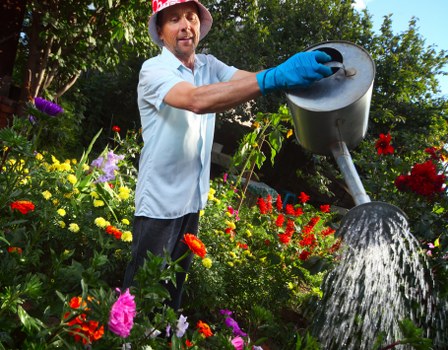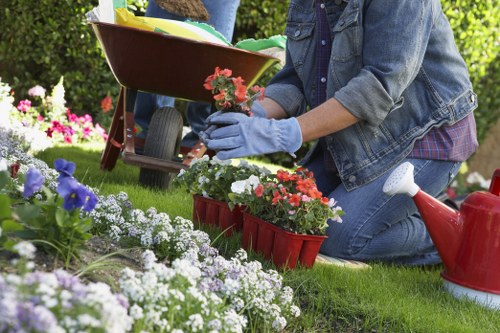Lawn Mowing Woodlands: A Gateway to Greener Spaces
Introduction to Lawn Mowing in Woodlands

Lawn mowing woodlands is more than just trimming grass; it is an art that blends careful maintenance with a love for nature. In our busy lives, maintaining green areas is both a necessity and a responsibility. This article explores the techniques, benefits, and local relevance of keeping woodland lawns neat and healthy.
The process involves careful planning, sustainable practices, and a deep respect for the environment. Our discussion aims to make these topics easily understandable even for those who are not experts. Whether you care for a small family yard or a larger woodland area, the right lawn mowing practices can transform your space.
Understanding the balance between aesthetic appeal and environmental care is critical. Maintaining woodlands not only provides a clean look but also contributes to the health of local ecosystems. With each cut, we protect and nurture nature, ensuring longevity and sustainability of our green spaces.
Essential Techniques and Tools for Lawn Mowing

When it comes to lawn mowing in woodlands, using the right tools is essential. Modern mowers, trimmers, and edging tools have made the job easier and more efficient. Whether you are a homeowner or a professional landscaper, upgrading to better equipment can significantly improve your results.
Many experts recommend regular maintenance schedules to ensure that the mowers work at their best. It is important to adjust the height of your mower to the type of grass you are trimming. This care will reduce the risk of damaging the grass and increase the overall look of your woodland area.
Moreover, safety is a primary concern. Wearing protective gear such as goggles and gloves and following manufacturer instructions helps avoid accidents. Additionally, learning basic maintenance, like cleaning out grass clippings and sharpening blades, is crucial to long-term equipment performance.
Benefits and Environmental Impact

The benefits of a well-maintained lawn extend beyond beauty. Strategic lawn mowing contributes to soil health, reduces allergens, and even supports local biodiversity. Allowing short grass to thrive creates a habitat for insects and small animals, ultimately enriching the entire ecosystem.
Lawn mowing woodlands responsibly can also combat issues like soil erosion and invasive species. Creating a rhythm of mowing and natural growth empowers gardeners and homeowners to sustain the woodland’s natural character while preventing overgrowth.
Furthermore, environmentally friendly mowing techniques include using electric mowers instead of traditional gasoline-powered machines. This change lowers emissions and supports overall green initiatives. Many communities now embrace energy-efficient yard care as part of their commitment to environmental sustainability.
Local Woodlands and Their Unique Features

Local woodlands are treasured areas that bring communities together. In small towns and larger suburban areas alike, these green spaces act as communal hubs, outdoor classrooms, and peaceful retreats. Lawn mowing in woodlands plays a significant role in preserving the beauty of these areas.
Many local councils now invest in professional lawn mowing services to ensure that these areas are maintained to a high standard. This not only guarantees a neat appearance but also helps preserve local flora and fauna. A well-kept woodland draws visitors and instills community pride.
In fact, several regions are known for their extraordinary woodlands—from historical parks to newly established nature preserves. Their proximity to local communities enhances opportunities for education, outdoor activities, and community-led conservation projects.
Local Relevance: Exploring Nearby Woodlands Areas

The importance of a clean, well-mowed woodland cannot be overstated, especially when we consider the local areas that surround our communities. Here are some of the closest woodlands areas that benefit from sustainable lawn mowing practices:
- Old Woodlands – Located in the heart of the community, Old Woodlands is celebrated for its historical trees and traditional landscape.
- New Woodlands – A recently revitalized space that blends modern design with natural beauty.
- Eastern Woodlands – Known for its morning light filtering through tall trees, creating a unique atmosphere.
- Western Woodlands – Offers a scenic view of sunsets and is a favorite spot for evening walks.
- Northern Woodlands – Pristine and serene, this area is often used for community mindfulness activities.
- Southern Woodlands – Rich in biodiversity and ideal for families exploring nature.
- Oak Woodlands – Famous for its towering oak trees and inspiring shade.
- Pine Woodlands – Provides a refreshing aroma and a space perfect for outdoor meditation.
- Maple Woodlands – Admired for its vibrant fall colors that attract photographers and nature lovers alike.
- Birch Woodlands – Offers a delicate beauty with its slender trees and soft light.
- Cedar Woodlands – Known for its distinct aroma and natural pest-repellent properties.
- Willow Woodlands – Often found near water bodies, creating a lush, reflective environment.
- Forest Woodlands – A dense, wild area ideal for adventurous explorers and environmental studies.
- River Woodlands – These woodlands border rivers, providing a soothing soundscape and a habitat for aquatic wildlife.
- Garden Woodlands – Integrates landscaped garden ideas with wild, natural elements, perfect for community gardens.
Each of these areas has its own charm and significance, offering something unique to reside in or visit. Their proximity to residential zones makes them vital parts of local culture and environmental conservation efforts.
Tips and Best Practices for Homeowners

Homeowners who take pride in their green spaces can benefit greatly from following simple, effective lawn mowing tips. Regular maintenance and attention to detail ensure your woodland looks tidy and remains a safe haven for local wildlife. One major tip is to mow at the right times—early mornings or late afternoons when the sun is gentle.
It is also essential to adjust your mower settings according to seasonal changes. In the summer, a slightly higher cut is recommended to retain moisture and promote deeper root growth. In the colder months, reducing the mowing frequency can help protect the grass from winter stress.
Another important practice is cleaning the mower deck after every use. This avoids buildup of clippings that can harbor pests or diseases, ensuring a healthier lawn. Regular inspection and timely servicing of equipment can extend its lifespan and improve performance.
Sustainable Practices in Lawn Mowing

Sustainable lawn mowing involves more than just cutting grass; it incorporates environmental sensitivity at every step. Choosing eco-friendly equipment and renewable energy sources, such as battery-powered mowers, can significantly reduce your carbon footprint. This not only benefits the atmosphere but supports broader community goals for a healthier environment.
Many experts emphasize that integrated pest management (IPM) should be part of your maintenance strategy. This means using natural methods for controlling pests, such as encouraging the development of beneficial insects. Such methods help maintain balance in your woodland ecosystem.
Water conservation is another key aspect. Efficient watering systems that work in tandem with proper lawn mowing can help prevent water waste. The combination of sustainable equipment, natural pest control, and smart water management creates an overall eco-friendly strategy that sets a positive precedent in the community.
Community and Economic Impact of Lawn Mowing

The influence of proper lawn mowing in woodlands is visible not only in the environment but also in local communities' economic and social framework. Well-kept woodlands attract tourists, create spaces for community events, and increase property values. This visible maintenance effort can elevate the reputation of an entire neighborhood.
Local businesses benefit from well-maintained areas as they often see increased foot traffic and higher neighborhood engagement. This improved aesthetic appeal leads to more investments in local infrastructure and beautification projects. In some cases, communities may even develop new social programs centered around conservation and landscape care.
Furthermore, public-private partnerships have emerged to support the care of communal woodlands. These collaborations focus on training programs, local employment, and ensuring that mowing practices meet stringent environmental guidelines. The result is a vibrant community where natural beauty and economic progress go hand in hand.
Looking Forward: Innovations in Lawn Mowing Technology

The future of lawn mowing in woodlands is bright, thanks to continuous advancements in technology. Innovations such as robotic mowers and GPS-guided mowing systems have started to make an impact. These tools not only improve efficiency but also reduce the manual labor involved in maintaining large woodland areas.
With the integration of smart technology, these machines are now capable of self-diagnosing issues and optimizing their own performance. This shift towards automation allows homeowners and local councils to free up time and resources to focus on other important conservation tasks. The balance between technology and nature continues to evolve for the better.
Additionally, sustainable fuel options and improved battery technologies are emerging as viable alternatives to traditional gas-powered models. Manufacturers are focusing on producing machines that are lighter, quieter, and environmentally friendly. These trends promise to redefine lawn care while honoring our commitment to health and harmony in the woodlands.
Final Thoughts and Recap

Lawn mowing in woodlands is a thoughtful blend of art, science, and environmental stewardship. This article has touched on various aspects, from essential techniques and safety tips to modern innovations and local community impact. Maintaining a clean, natural landscape requires a commitment to sustainability, proper care, and the use of advanced technology where applicable.
As communities continue to grow, the importance of preserving local green spaces becomes increasingly crucial. By adopting responsible mowing practices, we help conserve nature while enhancing the beauty and functionality of our surroundings. The journey towards a greener future begins with small, consistent actions that have long-lasting results.
Remember that every effort made to care for a woodland is a step towards protecting our environment. Whether you are a seasoned professional or a proud homeowner, integrating these best practices into your routine can make all the difference. Thank you for joining us in this exploration of sustainable lawn mowing for woodlands.
FAQs
Q1: What are the main benefits of proper lawn mowing in woodlands?
A1: Proper lawn mowing improves aesthetic appeal, promotes healthier grass, protects the local ecosystem, and prevents soil erosion. It also creates habitats for beneficial organisms and minimizes invasive species.
Q2: Which tools are recommended for maintaining woodland lawns?
A2: Modern electric or battery-powered mowers, trimmers, and edging tools are highly recommended. Regular maintenance tools like sharpeners and cleaning equipment also enhance equipment longevity.
Q3: How can sustainable practices reduce the environmental impact of lawn mowing?
A3: Switching to eco-friendly equipment, using natural pest control, and integrated water conservation techniques can greatly reduce carbon footprints and support sustainable practices.
Q4: Are there local services available for woodland lawn maintenance?
A4: Yes, many communities offer professional services and local government programs focused on sustainable woodland maintenance and community beautification projects.
Q5: What innovations are shaping the future of lawn mowing in woodlands?
A5: Advances like robotic mowers, GPS-guided systems, and sustainable fuel options are setting new standards for efficiency and eco-friendly lawn care.